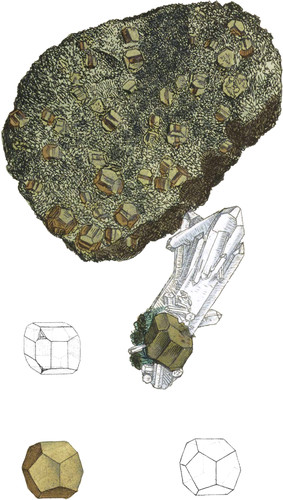 Enlarge
Enlarge
British Mineralogy
Sulphuret of Iron, Pyrites
- Div. 1. Crystallized.
Pyrites, so called from the facility with which sparks may be stricken from it, is very universal in this and all parts of the world; consequently, we are not surprised to find numerous varieties. Some, however, claim more particularly our attention, because they deviate from the more common order or appearance, even so as to become curious to the experienced, and much more so to the novice; and as they are more or less to be traced by orderly and beautiful gradations, they are the more necessary to be observed, being very instructive, and clearing our way to comprehend those varieties that would otherwise be difficult, I am obliged to His Grace the Duke of Bedford for the upper specimen, who with great liberality presented me with a valuable box of specimens from his mines at Tavistock in Devonshire, where there are most beautiful specimens of this substance found in great variety. The middle specimen is from some part of Cornwall, and was in Mr. Day’s collection. The lower specimen is from Tavistock.
It is admirable to see, if we trace these crystals from the primitive cube, that the twelve edges are alternately bevilled as it were, making two hexangular faces on the opposite side of each original cubic face, and in the whole eighteen faces. These hexangular faces, were they deeper, so as to efface the square or parallelogramic faces, would become twelve pentagonal faces. See the figure. Thus is produced the dodecaëdron with the pentagonal faces. The alternate striæ on these facets appear to indicate the arrangement of the minute cubic molecules; and as they aggregate to form larger figures, from the occurrence of particular circumstances, they are either formed into very perfect cubes, or more striated, or deviating toward the pentagonal dodecaëdron, in which many gradations occur.

